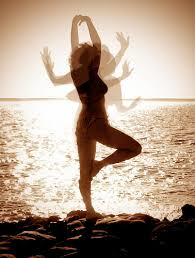 From the book, If Life is a Game, These Are the Rules by Dr. Cherie Carter-Scott "The Ten Rules For Being Human: 1. You will receive a body. 2. You will be presented with lessons. 3. There are no mistakes, only lessons. 4. Lessons are repeated until learned. 5. Learning does not end. 6. "There" is no better than "here." 7. Others are only mirrors of you. 8. What you make of your life is up to you. 9. All the answers lie inside of you. 10. You will forget all of this at birth." Everyone in class today chose a positive affirmation card from the deck that corresponds with the If Life is a Game book. Inside the book of cards it reads, "Acknowledge that you are the source of your manifestations." Song of Myself by Walt Whitman (1st 3 lines) "I celebrate myself, and sing myself, And what I assume you shall assume, For every atom belonging to me as good belongs to you." One of the cards from this deck is labeled abundance and it reminds us that the Universe has enough of everything for everyone. Whitman's stanza says the same thing to me. How can it not if you have the power to manifest what you want more of in your life? Rumi writes, “Be a spot of ground where nothing is growing, where something might be planted, a seed, possibly, from the Absolute.” The following poem is a great one for your yoga practice. Read on... We Have Come to Be Danced by Jewel Mathieson “We have come to be danced not the pretty dance not the pretty pretty, pick me, pick me dance but the claw our way back into the belly of the sacred, sensual animal dance the unhinged, unplugged, cat is out of its box dance the holding the precious moment in the palms of our hands and feet dance” When Mathieson says 'not the pretty dance', I "yogically" interpret that to mean don't worry about getting into the final pose, if there is one. Play, breathe and be present through the transitions. Be 'unhinged' on your yoga mat, allow your thoughts and ego to become 'unplugged' and find the tribal "sacred, sensual animal dance' within your practice. And, last but not least, Wild Geese by Mary Oliver, reminding us in our practice that you don't have to go all out; just move on your mat listening to the way your heart and body want to. “You do not have to be good. You do not have to walk on your knees For a hundred miles through the desert, repenting. You only have to let the soft animal of your body love what it loves.”
0 Comments
 Both Krishnamacharya and Desikachar translate Yoga Sutra 1.9 as, "Imagination is the comprehension of an object based only on words and expressions, even though the object is absent." Read the word after this sentence and then quickly close your eyes to see what image you come up with. Apple. What did you see? When I was asked to do this at a workshop a couple of years ago, I saw an eye as in "apple of my eye." Did you see an actual apple? Was it green, red, yellow, or maybe all three? Close your eyes again and see yourself taking a bite out of a juicy red apple and imagine how it tastes as the sweet juices flood your taste buds. If that was difficult for you, try again but replace the apple with a lemon. Bite into its sourness and see if your mouth really starts to water! "A daydream is a meal at which images are eaten. Some of us are gourmets, some gourmands, and a good many take their images precooked out of a can and swallow them down whole, absent-mindedly and with little relish."- W. H. Auden Vikalpa is a Sanskrit word that means imagination by using a mental process to form opinion, thoughts and beliefs. Our minds actually manifest a link between our initial thought and our imagined reaction. Why did your mouth water when you imagined biting into a lemon? The reality is that the lemon you saw in your mind is imperceptible; it doesn't actually exist in the tangible sense. But your mind hooked your body up with the thought and your mouth physically reacted as though the lemon was very real. We do this all the time when we try to imagine outcomes! Sometimes this is vary good for us and other times, so bad, our imagination stresses us out. "Often we speak of a thought process, which is one of living in the future. The mind is really taking the current thoughts, rearranging them this or that way, and then fantasizing some new combination as being the future, even though that fantasy is occurring in the present moment." swamij.com Try to daydream a yoga pose. Let's choose handstand. Don't worry! We are only practicing the pose in our head. Close your eyes and see yourself easily floating up in to a handstand. Feel how strong your arms are. Feel the power of balance in each hand. Feel how steady, effortless and strong this pose feels. Notice the sensation of blood slowly coursing down towards the head. Feel how light and unburdened the souls of the feet are as they explore air, rather than earth. Feel a sense of accomplishment. Daydreaming can be a powerful tool. Edgar Allen Poe wrote, " Those who dream by day are cognizant of many things which escape those who dream only by night." I dream... (Poem) I dream of floating away on a cloud I dream of catching a falling star I dream of my prince charming I dream of how I'll save him from the dragon I dream of cows on the moon And pink grass I dream of old ladies knitting socks I dream the twelve Olympians are real I dream I'll meet them someday I dream of vast sugar cane fields I dream of a bed of roses And how prickly that must be I dream of firefly friends I dream of a lighting bug show I dream of riding a striped horse down the aisle I dream of hot air balloons I dream of polar bears And penguins I dream of snow I dream of rain I dream of summer I dream of fall I dream of day And night I dream of the moon I dream of stars I dream of going to Mars I dream of how I'll be queen of the Martians I dream of how I'll love my subjects And people always said I belonged on another planet I dream of love I dream of faith I dream of hope I dream of culture I dream of life And I dream sweet dream By Sai Srujana 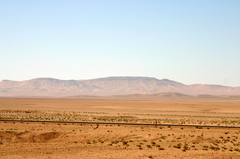 I'm not really sure what this theme is about. It may be perspective or something about love or maybe you read this and it triggers a different meaning for you... I've been enjoying all the Olympic briefs on Yahoo as I make my way into my email each morning. The ups and downs posted are what you would expect every time the Olympics role around. The heartbroken upsets, the stellar wins. Making it even more interesting are how everyone is there with their own unique story. I watched a montage of falls and crashes edited together, some painful to watch. I saw two bobsledders dump over, their heads plowed into the ice-hard shell of the track the entire way down. You know the long jump skiers? They always look like they are simply soaring through the air, but I saw one get dumped from the sky. A woman snowboarder fell backwards and cracked her helmet as her head hit ground behind her. I saw a skater jump into the air to land a triple but his picks hit the landing first and the hard ice met his hip. I saw a skier break into tears when asked about his recently deceased brother. I saw a slope style skier extend his stay in Sochi to save and bring home 5 stray dogs. I like all these stories; they entertain me for the span the Olympics is on. But on this Yahoo news page, of which it seemed to be mostly about the Olympics, I had to wonder how many people caught the story way off to the side under the headlines titled "4-year-old Syrian refugee found alone in desert". Maybe that is a story most would skip but I had to read it when I clicked on the title and then saw the picture. The picture shows endless dry desert sand as far as the picture details. There are four UN humanitarian workers (and a fifth taking the picture). One is bent over addressing this little boy who appears to just continue walking, steadfastly ahead, holding his only belongings in a flimsy plastic bag. He doesn't appear to be crying or despairing; one little foot is stepping in front of the other as though he knows there is nothing to do but move forward. He was later helped to cross the Jordan border where he was reunited with his mom. Apparently they got separated crossing the dessert? Was she walking too fast for his little legs? Maybe she had too many kids to carry? It's all based on perspective. "I believe everyone should have a broad picture of how the universe operates and our place in it. It is a basic human desire. And it also puts our worries in perspective." by Stephen Hawking After reading the article, I connected to the photographer's Twitter to read the comments people had posted. One comment, though written in Spanish, said that in context with that particular picture, it is true what is being said about this boy. But that we should look at the other pictures taken along with this one showing hundreds of people making their way across the dessert to flee Syria. So I looked up the other pictures. I then could understand how this little guy got swallowed up in the crowd. So we have the most expensive Olympics being put on about a thousand miles away from where people are so desperate to leave their country they are marching across this desert. I am not judging; I most certainly am not bashing the Olympics. In fact, I'm not sure what I've written is even opinion; I am just stating the irony of what is. Two totally different things going on in the same area of the world at the same time. What draws your attention and why? Do you feel this is a theme about perspective or maybe a theme about loving those close to you even more? Is it something altogether different? "I find hope in the darkest of days, and focus in the brightest. I do not judge the universe." Dalai Lama 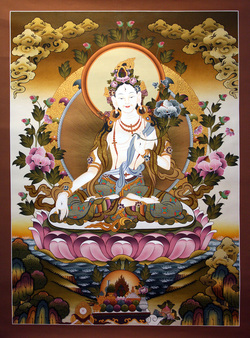 I was asked to offer more themes about the various Hindu and Buddhist deities so today's theme is about one of the most popular and well-known boddhisattvas spanning many cultures, White Tara. Tara, in Sanskrit, means "star" or "one who saves" and "one who ferries across". White Tara is a figure of immeasurable compassion and longevity in life. Known as "The Mother of all Buddhas", stories say she has more compassion for all people than a mother towards her very own child. Born from one of Avalokite'svara [ah vah lo key taysh vah ra] tears, another boddhisattva known for compassion, White Tara is peaceful and beautiful and transformational. The story tells that Avalokite'svara was so saddened by human pain and suffering that his tears formed a lake. A lotus appeared from the depths of the water revealing White Tara. Water is one of the symbols she is associated with and she is said to, symbolically, carry people across waters. Documentation of Tara goes back 5,000 years to Finland writings. Native Americans referred to her as Star, and they thanked her for earth's bounties. She is recognized in Hinduism and Buddhism and in Chinese culture is closely tied to Kuan Yin. There are twenty-one delineations of the Goddess Tara, most of which, are differentiated by color and consciousness. Green Tara would be the other most popular and well-known. There are many different depictions of White Tara so being able to recognize her symbols will help you discern if you are looking at White Tara versus another deity. Sometimes she is standing, other times seated. When she is seated, you will most often find her in lotus position, symbolic of her calm nature. She has her right hand open in a gesture of offering and the other hand, while often described as being in abaya mudra, is actually in a variation of vitarka mudra meaning good fortune (as her ring finger is touching her thumb). White Tara, as her name suggests, is always depicted with flawless pale white skin. (She is easily distinguishable from Green Tara whose skin color is, you guessed it, green!) White Tara is prominently recognized by her seven eyes. There are three on her head (one where her 3rd eye would be), one on each palm and one on the sole of each foot. With seven eyes, she is better able to see all the places she is needed. I like the following description: "Her seven eyes stand for her perception of suffering that is apparent (the two we normally have,) that is psychological/spiritual (the one in her forehead,) and that is inherent in activity (in her palms,) and in what is usually considered as progress (in her soles.)" khandro.net Technically, White Tara is a Boddhisattva; one who has reached enlightenment but chooses to remain in the earthly cycle of life and death to help others. She technically could reach her own nirvana by becoming a Buddha but she chooses to stay and help others reach their nirvana, instead. She is considered the only female eligible for Buddha status and was given the opportunity to reincarnate as a man to do so. She declined stating , "There are many who wish to gain enlightenment in a man's form, And there are few who wish to work for the welfare of living beings in a female form. Therefore may I, in a female body, work for the welfare of all beings, until such time as all humanity has found its fullness." Some argue that in her enlightened form, she is neither man nor woman; she has transcended being defined by a form. Tara is the savior who can protect one from worldly dangers. If you were on safari in Africa, perhaps you would appeal to her to protect you from lions. If you were in Alaska, you may seek protection from avalanches. If you live (for some unexplainable reason!) in Chicago, you may seek rescue from cold and snow. Spiritually, she protects us from elements that may lead to our suffering such as greed and jealousy. Tara is said to alleviate our eight external fears, which correspond to eight internal fears. 1. floods > attachment 2. fire > anger 3. elephants > ignorance 4. snakes >jealousy 5. lions > pride 6. imprisonment/chains > miserliness 7. thieves > wrong views 8. ghosts > doubt In her headdress, one sees Amitābha [ah me tah bah], "The Buddha of Infinite Light." She holds a lotus flower with three buds in varying stages of being open; the seed represents past Buddhas, the full bloom symbolizes the present Buddha and the bud represents the future Buddha. Tara, herself, the essence of all three. In Tibetan Buddhism, mantras are considered to be the place where the energy of a deity can be found and called upon. By reciting a deity's mantra, you transcend yourself to their realm of light. The White Tara Mantra, long version is: OM TARE TUTARE TURE MAMA AYUR PUNYE JNANA PUTIN KURU SVAHA. The shorter version can be used to call upon any and all of the Tara's: OM TARE TUTARE TURE SOHA (svaha in Sanskrit, soha in Tibetan) It means liberation from samsara; Tara relieves us of our sufferings. " There are so many inner obstacles to the development of your mind, and these inner obstacles create many outer obstacles. Therefore, for the success of your Dharma practice, of your actualizing the graduated path to enlightenment, you must rely upon a special deity, or buddha, such as Tara. All the actions of the buddhas have manifested in this female aspect of buddha, Tara the Liberator, in order to help living beings to accomplish successfully both temporal and ultimate happiness." ----- Lama Zopa Rinpoche at Nepal, May 1987 The two Tara songs I used in class were "Tare Tuttare" by Deva Premal and White Tara's mantra- follow this link to hear on youtube: http://www.youtube.com/watch?v=GZZ-pFa7MJM 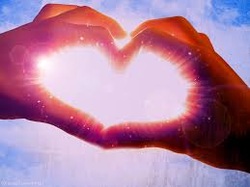 Ahhh... Valentine's Day. It's the day where we hand out Valentine cards, buy lots of chocolate, and send flowers. In a newer relationship, we panic about what is the right thing to buy/give to show the right amount of our affection. Is the gift enough to say I really really like you or is the gift too much too soon, maybe sending messages of love and commitment we aren't ready to express? If love is why we are here, if love is our purpose, our true essence, and our natural state of being, why have we made it this hard? A couple years ago for my Valentine's class, I brought in chocolate heart shaped candy. I didn't do that this year. This year, I brought in something much bigger and much longer lasting. It is something you can accept and take home with you and keep forever. It is also something you may choose to reject if you are not ready for it. In that case, however, I ask you to leave it behind to be recycled into the earth for others. This time, I brought in love. Close your eyes for a moment and feel what love feels like. Imagine a hug wrapping its way around you. A warmth pervading your senses with a sense of protection. Because love feels protecting, right? Why does it? Love seems to let us know we are accepted. We are okay just the way we are. And under that awning, there is no room for fear or inadequacies. Love will hold our hand and allow us to stretch out as far as we want to fill our space to its highest potential. So even though it is Valentine's Day, a day of expressing outward affection for others, our practice should be to focus on loving ourselves. We've all heard the numerous quotes touting 'you cannot love someone else until you love yourself'. And maybe we read that and nod our heads in affirmation. But then why do we struggle with doing it, with loving ourselves? Alan Cohen was once on the radio giving advice to a caller who said she was working very hard on loving herself. And Alan said something like stop working. He said if I were to tell you that the place where you love yourself already exists within you, it will no longer become work. It then becomes a place to go to. Ahhh. So much easier. Sufi poet Rumi wrote, “Your task is not to seek for love, but merely to seek and find all the barriers within yourself that you have built against it.” Rumi is also telling us, from thousands of years ago (!), that our self love is a place within that never leaves us. If you are frustrated with yourself, mentally or physically, I want you to see that as little. Love is BIG. If your ego voice is chastising you for making a poor decision, I want you to notice how that voice is little. How love is BIG. If you are feeling inadequate tonight on the mat because your poses aren't good enough, you can yell that as loud as you want. But I will yell back at you louder your poses are good enough for me, why not for you? In fact, your poses are perfect for your body tonight. Because love is LOUDER. If you are feeling lonely and Valentine's Day depresses you, understand loneliness is temporary. And being alone, quite a different word, can be a great thing. It may even give you the time you need to seek out the place inside I was telling you about where you always have love for yourself...and that love is HUGE. Cord cutting is a "psychic" term, if you will, for separating yourself from negative energies that seem to drain you. An example would be someone you know that, every time you are around them, you just feel tired or energetically drained. Most of us know one or more of these people! They don't mean to drain our energy so it is our responsibility to keep our own energy safe.
Psychic John Holland released an email recently talking about this very topic. But he took cord cutting a step farther to include thoughts and habits that drain our energy. This hadn't occurred to me before and I felt this was a worthy idea to pass on. So, let me back up for a moment. What cords?!!! The premise is that you form a cord of energy with everyone you meet. But that cord does not die off when certain relationships do. In fact, we remain connected to everyone's energy unless we specifically do a cord cutting. You can even separate from only the negative aspects of a relationship rather than the entire person. Although the word cutting sounds painful, this process is not and the other person will have no idea you have done this unless you tell them. They may feel distanced from you but unsure as to why. John Holland writes, "When you focus and direct your thoughts and energy on a particular person, place, object, situation, or even an uncompleted project, you’ll establish an energetic cord with whatever you’re focusing on. " Holland makes the analogy of a flashlight being left on and the battery's energy slowly draining away. So what thoughts have been hoarding your energy pushing other thoughts away? What projects have completely taken over your mind? Just because you cut the energetic cord to someone or something, does not mean you are cutting them out of your life (unless that is your intention), and it does not mean you love them any less. It means you are seeking out the healthy side of a relationship so there is balance for your energy pool. John defines some examples of "potential draining energy cords": •Unhealthy diet and lack of exercise •Relationship and family issues •Uncompleted projects •Unresolved finance issues, such as last years’ un-filed taxes •Excessive worrying •Taking on the problems of a family member or friend How fabulous that we can release ourselves from these worries? Taxes?? Come on!!! So. You are on board. You are ready to let go of negative energy burdens. What do you do? There are a few different techniques I have come across for cord cutting. Essentially, find a quiet place where you can meditate for a time. It may be as little as 5 minutes but you need to access a state of calm. Set your intention. What is it exactly you intend to do? I intend to cut away the cord that binds me to worrying about _______. Or, I intend to cut the energy cord between myself and my ex because it is time to for me to let go of their negative energy. Something like that, but be clear. Remember that not all energy cords are bad; many bring us love and positive energy. You are cutting the cord(s) that inhibit your growth; that stop you from moving forward. In your mind's eye, see the cords coming out from your navel. Intuitively feel for the one that is connected to your source of negative energy. If you are comfortable with this, ask Archangel Michael to help you as cord cutting is his specialty! Then visualize whatever tool you would like to use and cut the cord away. See it go reeling away from you and, as it does, notice it takes its negative energy with it and that you already feel lighter. Is this the day you are ready to release your draining stressors? Separate from the thoughts that plague you most? "Be miserable. Or motivate yourself. Whatever has to be done, it's always your choice." Wayne Dyer 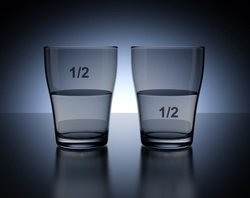 "An optimist will tell you the glass is half-full; the pessimist, half-empty; and the engineer will tell you the glass is twice the size it needs to be." by Oscar Wilde Put the Glass Down- Author Unknown "A psychologist walked around a room while teaching stress management to an audience. As she raised a glass of water, everyone expected they'd be asked the "half empty or half full" question. Instead, with a smile on her face, she inquired: "How heavy is this glass of water?" Answers called out ranged from 8 oz. to 20 oz. She replied, "The absolute weight doesn't matter. It depends on how long I hold it. If I hold it for a minute, it's not a problem. If I hold it for an hour, I'll have an ache in my arm. If I hold it for a day, my arm will feel numb and paralyzed. In each case, the weight of the glass doesn't change, but the longer I hold it, the heavier it becomes." She continued, "The stresses and worries in life are like that glass of water. Think about them for a while and nothing happens. Think about them a bit longer and they begin to hurt. And if you think about them all day long, you will feel paralyzed – incapable of doing anything." It’s important to remember to let go of your stresses. As early in the evening as you can, put all your burdens down. Don't carry them through the evening and into the night. Remember to put the glass down!" The Important Things in Life- Author Unknown "A philosophy professor stood before his class with some items on the table in front of him. When the class began, wordlessly he picked up a very large and empty mayonnaise jar and proceeded to fill it with rocks, about 2 inches in diameter. He then asked the students if the jar was full. They agreed that it was. So the professor then picked up a box of pebbles and poured them into the jar. He shook the jar lightly. The pebbles, of course, rolled into the open areas between the rocks. He then asked the students again if the jar was full. They agreed it was. The professor picked up a box of sand and poured it into the jar. Of course, the sand filled up everything else. He then asked once more if the jar was full. The students responded with a unanimous “Yes.” “Now,” said the professor, “I want you to recognize that this jar represents your life. The rocks are the important things – your family, your partner, your health, your children – things that if everything else was lost and only they remained, your life would still be full. The pebbles are the other things that matter – like your job, your house, your car. The sand is everything else. The small stuff.” “If you put the sand into the jar first,” he continued “there is no room for the pebbles or the rocks. The same goes for your life. If you spend all your time and energy on the small stuff, you will never have room for the things that are important to you. Pay attention to the things that are critical to your happiness. Play with your children. Take your partner out dancing. There will always be time to go to work, clean the house, give a dinner party and fix the disposal. Take care of the rocks first – the things that really matter. Set your priorities. The rest is just sand.” Just make sure you fill your glass with the people and things you love most. Today's theme is based around Mary Oliver's quote, "Can you live with what the world is offering you today?"
We wove dolphin pose into our practice today to help tune into dolphin's intuitive wisdom. The dolphin, able to dive deep and bring things back up to the surface. Unafraid to surface and resurface. We, as humans, slightly (!) more afraid of allowing feelings to surface. We attempt to push them down but, eventually, they have no choice but to float back up. Can you live with what the world is offering you today? We also explored different poses with eagle arms. An eagle sees with precision-like clarity. Able to soar up high yet see below the water's surface. This amazing creature also willing to dive down and resurface to the sky over and over again. Can you live with what the world is offering you today? It's an interesting question . It's a question that makes you settle back and let go. I just can't imagine anyone saying no! We may feel that way sometimes but, when it really comes down to it, when asked that question, wouldn't you suddenly realize you are strong and, yes, you can live with what the world is offering you today. Maybe the question is really more of a reminder than a serious question. On your yoga mat- can you live with where your body is today? Of course you can. It may not be reacting as you would like but you can live with it. It is the ego that wants you to deflate into a no answer. Bald eagles have 7,000 feathers, which made me think of the crown chakra lotus symbolized by 1000 petals. Sonia Choquette says these 1000 petals represent your 1000 gifts. I challenge you to write down some of yours. Stephen Cope writes, "Yogis believed that every human being is born with a special gift. This gift, for each of us, is the doorway to a fulfilled life. It is the doorway to our own particular path, our vocation, our calling—our sacred duty. Yogis called this vocation our dharma. All of life is seen as an opportunity to realize and manifest this unique calling—this unique dharma. " The five principles of Reiki are as follows: Just for today, I let go of worry Just for today, I let go of anger Just for today, I will express gratitude. Just for today, I will do my work honestly. Just for today, I will be kind to my neighbor and every living thing. I ask you again, can you live with what the world is offering you today? Both Indian sage Patanjali and Buddha taught that when one is able to adhere to the states of mind known as brahmaviharas, one becomes open to experiencing unconditional love. These four states of mind, as defined in yoga sutra 1.33, are loving kindness, compassion, joy and equanimity.
“By cultivating attitudes of friendliness toward happiness, compassion toward suffering, delight toward virtue, and equanimity toward vice, thoughts become purified, and the obstacles to self-knowledge are lessened.” Quote from the book, The Secret Power of Yoga These four qualities may sound easy enough. But, are they that easy when you are tested? In other words, can you be kind to someone in their happiness even when you are not happy or tolerant of what is creating their happiness. An example would be smoking. The person smoking is happy with their cigarette. You, on the other hand, may not appreciate the smell. Can you still be kind to that person in their happiness or are you tempted to send a glare in their direction? The second quality is compassion and the example I gave in class had to do with homeless person A, B and C. Person A has worked all their lif but due to tough times, lost heir job and home. Person B is homeless due to poor choices like drugs, and alcohol. Person C is homepless for the same reason Person B is except that this person is in your family. And you r family has felt the ripples and repercussions of Person C's decisions. Can you feel equal compassion towards them all? We tend to feel less compassionate when someone has created their own suffering. Dalai Lama- "Through compassion you find that all human beings are just like you." The third quality is in finding joy for those who embody noble traits as well as those who struggle a little harder to find theirs. And, equanimity to those whose actions oppose your values. Martin Luther King Jr said, "The ultimate measure of a person is not where they stand in moments of comfort and convenience, but where they stand in times of challenge and controversy." By practicing these four "locks", one obtains the key to unconditional love. Stated a little differently, Swami Satchidananda translates Yoga Sutra I.33 as, "By cultivating attitudes of friendliness toward the happy, compassion for the unhappy, delight in the virtuous, and disregard toward the wicked, the mind-stuff retains its undisturbed calmness...If you use the right key with the right person, you will retain your peace." Author Dr. Gary Chapman writes about the five categories people fall under in regards to interpreting love. They are: People who need to hear they are loved, people who need quality time together to ensure they are loved, those who perceive gifts as a form of love, those who feel someone stepping up to help out with things defines love and those that translate physical touch into love. Walk with me by waters edge by Jeff Kaplan "Walk with me by waters edge, Hug like the wave hugs the shore, touch like the hush of waters ebb, Kiss like the sun melts into the sea. Listen to my heartbeat, from a low rumble, to a quiet touch, from a rush, to a tight embrace, then, a slow release. On a bed of sand and shell, Where lovers fall and rise, On a blanket of starry nights We might find you and I. Walk with me by waters edge, So our travels may be long not lonely Our lives be a gift that never ever end Hope and dreams to warm and hold. May the promises made by moon lit Dance with angels at mornings light Ripple through years of peaceful nights And a rainbow after every storms plight. Will you walk with me by waters edge..." So, yoga student Russ asked me, if we have a third eye (referring to the 6th chakra), do we have a third ear? His question, I believe, was more of a symbolic reference that if the third eye helps you "look" within, can you re-direct a "third ear" to better hear what your inner Spirit has to say. But yet, his question went on to ponder the idea of listening to sounds, such as music, outside the body as well as listening to our bodies. Here's what I've got...
It turns out there is a reference to a term called the third ear but not in the context of yoga. Quoting an article by Bruna Martinuzzi called The Third Ear: A Powerful Tool To Becoming A Better Listener, she writes, "The "third ear," a concept introduced by psychoanalyst Theodor Reik, refers to the practice of listening for the deeper layers of meaning in order to glean what has not been said outright. It means perceiving the emotional underpinnings conveyed when someone is speaking to you." Go back to the part where it says "what has not been said outright." In other words, can you read between the lines. The problem is that most of us aren't listening well enough in the first place to even hear what the lines were; forget about what they are inferring! In this context, one would have to develop their listening skills first. I write the word 'develop' purposefully. To develop something insinuates you need to practice at it, right? To develop the intuitive aspects of your third eye, one would need to practice meditating and being still, maybe some pranayama. You have to work at it. To develop this definition of the third ear, you need to work at hearing what is being said. So, suppose you are eager and ready to start practicing but no one is around to engage in conversation. Close your eyes and focus in on the first sound you notice. After a moment, go beyond that notice to something else you hear in the background that probably isn't as loud as the first. Continue to expand your hearing until you hear it all. And I do mean all! Did you notice your own breath or heartbeat? Besides references to psychologists trying to infer what their patients are telling them, I did come across another reference to this third ear idea that is a little more in lines with the third eye. It was more the idea that if you could tune in to this invisible hearing device, you can teach yourself to hear your inner thoughts (not to be confused with the millions of thoughts that run through your head each day!) as well as other's thoughts. I cannot legitimize this information off the internet but someone on a blog mentioned trying to focus on the triangle that connects your two ears and your third eye for a deeper way to meditate. In class, we meditated using the following technique: You sit comfortably and close your eyes. Keeping your eyes closed, you shift your gaze to the 3rd eye chakra, the space between the eye brows and slightly above. Breath in and out. After a few moments, when you inhale, say the "o" part of OM in your head but see the vibration of that "o" coming in through the 3rd eye. After a few rounds of that, add the "mm" to your exhale. See the "o" energy coming in, the "mm" energy moving out. Lastly, say the "mm" part out loud like a hum. Namaste. I give a cheer I hear my ear the one you cannot see the one that knows my inner soul and who I aim to be. This third ear so very near quotes my heart with pride trust love peace bliss already deep inside. |
Archives
March 2024
|
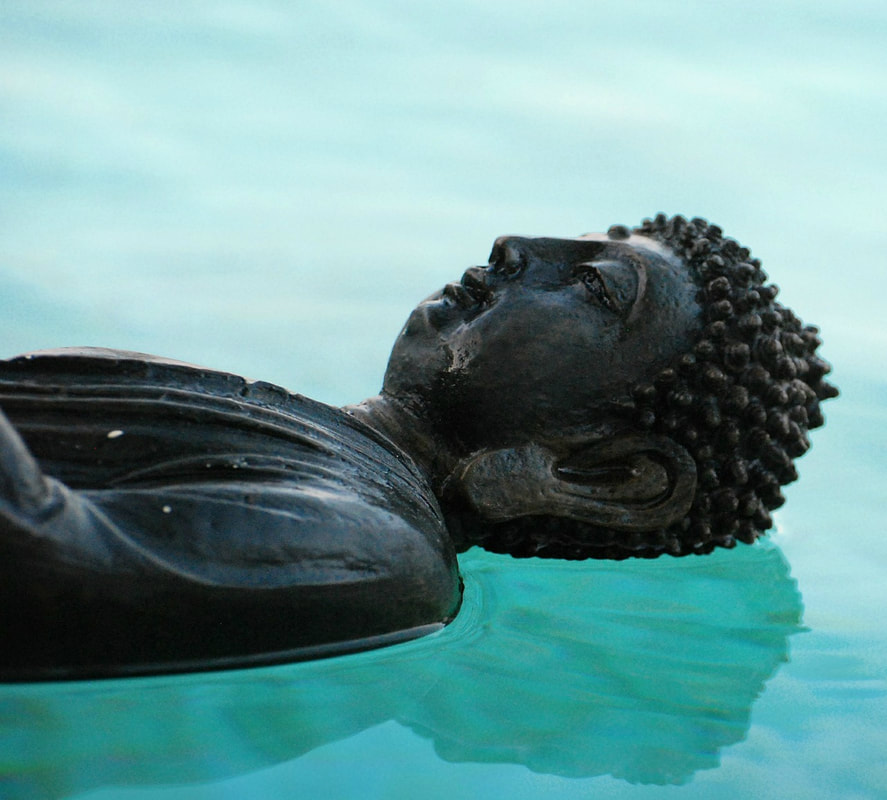
 RSS Feed
RSS Feed